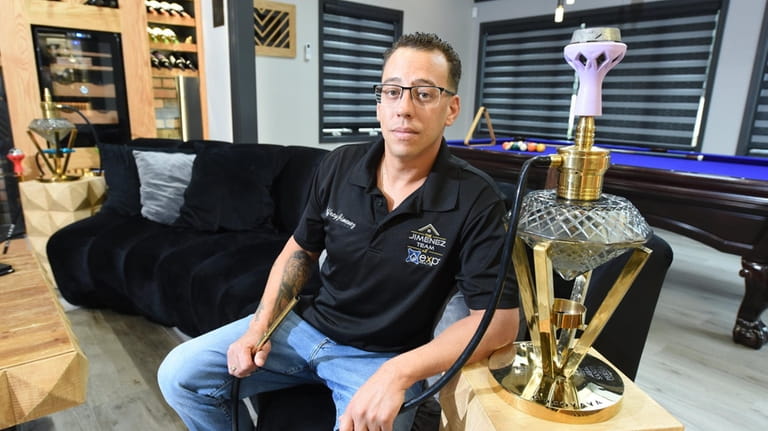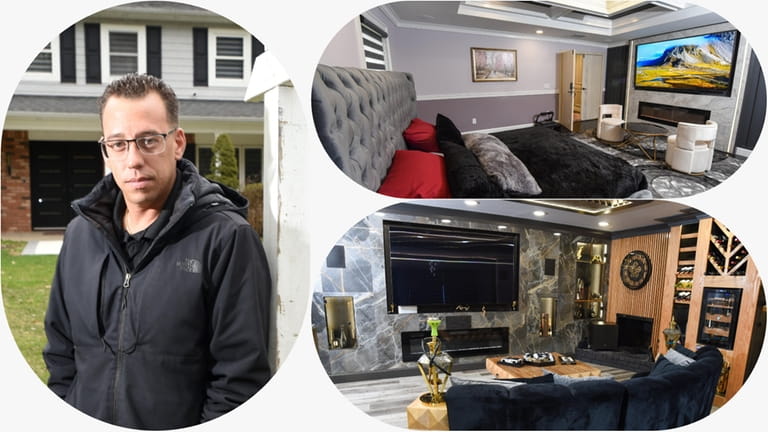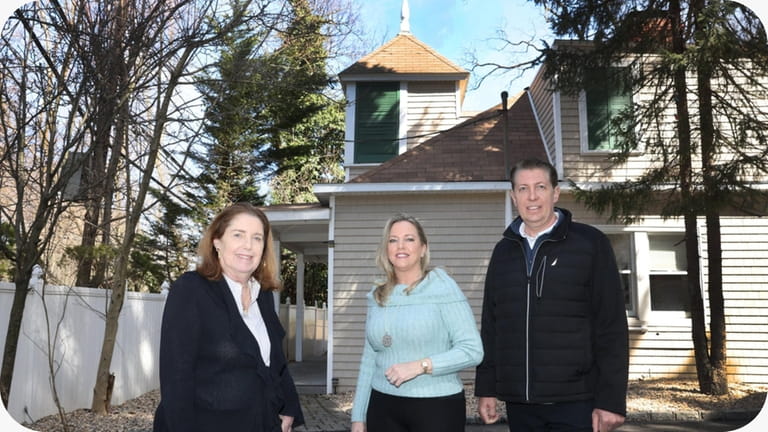Are custom house features dealbreakers for buyers, sellers?
Listing photos highlight a home’s unique features: recording studios, indoor pools, bowling alleys; brick-lined wine cellars, a basement disguised as an Italian pizza shop.
But the anticipated appeal of a house with custom features does not always translate to a wider profit margin for sellers; and for listing agents, what might seem a selling point can also be a deal-breaker.
"I think that the biggest challenge," said Daniel Gale agent Peggy Moriarty, "is trying to break the news that the homeowners have spent a fortune on whatever this specific room is, and nobody has the same passion, and they don’t want to pay for it."
As vice president of Center Island Contracting, Evan Lewitas has seen an increase in requests for custom features like home offices and children's homework areas over the past several years. But among his clients' unique requests is a current project: a homeowner is adding a second story to a house for the installation of a golf simulator room.
"He needs the height — you can't do it in your basement," Lewitas said. "When you build a second story, you can pick the ceiling height, and that'll give him the 10-foot ceilings he requires."
The job is in the preliminary permit phase, he said, but the starting price for a second-story addition is $150,000. The price of a golf simulator varies. The Medford-based company Golf Pro Delivered installs custom golf simulators that can cost anywhere from around $50,000 to over $100,000, according to executive assistant John Manson. A DIY golf simulator kit might start around $30,000, he said.
Profit aside, an amenity suited to the current owner — a fishing tackle room, shiny purple kitchen cabinetry, sapphire-blue granite tile — may drain the buyer pool.
And finding that buyer, who wants the house for — not in spite of — its custom features?
"It’s like finding a needle in the haystack," Moriarty said.
And the homebuying process on Long Island is often protracted as it is.
Do buyers like custom features?
I think that the biggest challenge is trying to break the news that the homeowners have spent a fortune ... and nobody has the same passion, and they don’t want to pay for it.
— Daniel Gale agent Peggy Moriarty
When preparing a home for sale, the common advice to owners is to remove personal effects, including photographs and items that nod to the owner’s personality. The goal is to present the space almost like a hotel room, said Laura Zambratto, an associate real estate broker for Daniel Gale Sotheby’s International Realty, so that prospective buyers can picture themselves inhabiting it.
"The more customized something is towards a specific seller, and their tastes and needs, the less buyers will be out there to be interested in that very same thing," said Zambratto.

The ultramodern aesthetic of this Huntington house is making it a challenge for EXP Realty agent Jeffrey Jimenez, above, to sell.
You’ve got to fall in love with this style, and if you don’t love the style then it’s not the house for you.
— Jeffrey Jimenez
In January, EXP Realty agent Jeffrey Jimenez listed a four-bed, four-bath smart house in Huntington. The 1-acre Austin Lane property is priced at $1.4 million, but offers so far have been below asking.
With sleek black-stained floors, a poker room, wooden accent walls and a pHountain water filtration system, the two-story house has an ultramodern aesthetic. The garage has been repurposed as a second primary bedroom.
The specificity of the house has proved a speed bump on the road to a sale for Jimenez.
"It makes it feel like more of a place that people want to visit as opposed to a place where people want to live," Jimenez said.
The sellers have, in fact, used the house as a vacation property, and are looking for "the right buyer," Jimenez said.

Among the customizations in the home Jimenez is representing are black-stained floors and wooden accent walls. Credit: Elizabeth Sagarin
"My approach to it is, you’ve got to fall in love with this style, and if you don’t love the style then it’s not the house for you," he said. Jimenez acknowledged that the property "stands out like a sore thumb" among listings of comparable price.
And the appeal of various features is subjective. Whether an amenity appeals to a buyer depends on what the buyer is looking for.
Jimenez's listing is particularly specific: It is to be sold fully-furnished, televisions and sound systems included.
"If it’s your taste, it flows very nice," Jimenez said. "It’s very well-appointed; it has some very unique features to it that most homes in this price range don’t even have."
How do house flippers handle customized homes?

Peggy Moriarty, left, with Christine and Jack Cohen, who flip houses. Credit: Debbie Egan-Chin
We buy houses that have those unique things, and we tear all of that out.
— Jack Cohen
Jack and Christiane Cohen, who are in their 50s and based in Lloyd Harbor, have made a career of flipping houses. Having flipped his first house at age 25, Jack Cohen has seen the gamut of renovation projects. One house in Laurel Hollow, he recalled, had a movie theater and pool, balconies off almost every bedroom, 9½ bathrooms and an art studio.
Beneath a slate composite roof, the castle-like house included a walkout basement with 10-foot ceilings and three upper floors. Even the attic had ceilings at least 10 feet high, Cohen said. Each bedroom had its own bathroom with a Jacuzzi tub.
But what seemed like selling points were not quite so.
"That was a tough sell because nobody wanted this giant house," Cohen said. "It was just too big for people."
Everything inside was oversized. There were a dining room table that sat an estimated 20 people, four fireplaces and tile that measured 2 by 4 or 6 feet. Every room had a chandelier; and nobody was into the spa tubs, he added.
"That house took a long time to sell," Cohen said of the listing, which sat on the market for about a year and sold for $2.33 million — just over half its initial $4 million asking price "Even though it was magnificent, you know, it took a unique buyer."
In trying to remodel what might be a hard — or specific — sell, as house flippers the Cohens try to appeal to the widest audience possible. This means cultivating a neutral color scheme, painting walls shades of white and changing bathroom tile to popular options like white porcelain.
For more prominent features, like additional but impractical rooms installed by homeowners on a budget, the Cohens have a different strategy. If minimal, low-cost renovations will help create a more versatile space, the Cohens will make adjustments before reselling the flipped home. This can include removing walls to turn several small spaces into a more open floor plan.
"We buy houses that have those unique things, and we tear all of that out," Jack said.
The likelihood is a buyer might see the impracticality and feel the need to remove it anyway, he explained. If features are made of drywall, he said, the cost of removal might be lower than the cost of having the house sit on the market indefinitely.
"That 5, $10,000 investment — if that makes your house sell in the next 30 days, does it make financial sense?" he mused. "I say yes."
To appeal to a wide audience, the goal is to offer prospective buyers "just the canvas" to work with. A blank, clean room with white walls and good lighting is what most buyers want, Cohen said.
"And then, they can put their finishing touch in," he said. "They could put bookshelves if they want to make it a library, right? They can put in a bar, or pool table, whatever they want to do."
If a home's distinctive features are permanent or too expensive to remove, the agent must decide how to market the home accordingly. Experts who spoke with Newsday said they would lean into well-constructed features that could not be removed or changed. When it comes time to sell, how the home's features are framed depends on the preferences of the agent and buyer.
Undoing customizations and letting go
Sellers should bear in mind that buyers will likely want to make changes to a home, said Laura Zambratto, of Daniel Gale Sotheby's International Realty. Credit: Debbie Egan-Chin
The most unemotional sellers are the sellers that do the best.
— Laura Zambratto
Low-budget, high-reward improvements Cohen suggested include changing doorknobs and hinges to a neutral, modern-looking stainless steel, changing black toggle-style light switches to their decorative counterparts and refreshing the surrounding plates.
"If you just do the light switches and the outlets, the doorknobs and the hinges," Cohen said. "If you just do that — night-and-day difference. The amount of money you’ll make selling your house will be tremendous."
The next step, he said, would be replacing old-style ceiling fans with white ceiling fans with four lights each, and spending $12 or $15 on white window shades. One step further would be installing base molding, then casing around the doors and windows.
Each improvement Cohen recommends trends toward standard, not custom, and thinking smaller, not bigger.
"The most unemotional sellers are the sellers that do the best," Zambratto said.
The value the homeowner places on certain pieces of furniture, for example, is "so personalized." A buyer will likely want to make changes, so it is important for sellers to "almost disengage" emotionally from the house.
"It’s hard because the homeowner put their heart and soul in it; usually it’s an emotional decision that they made because of whatever their passions are," Moriarty said. "And then we have to try to sell it to somebody else and have them pay up for it."

